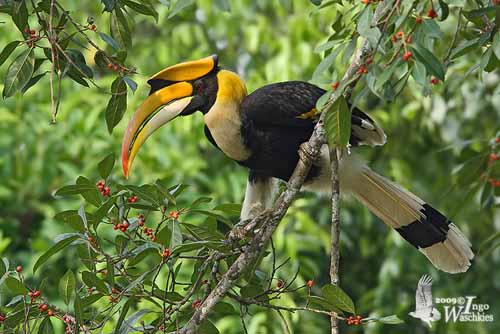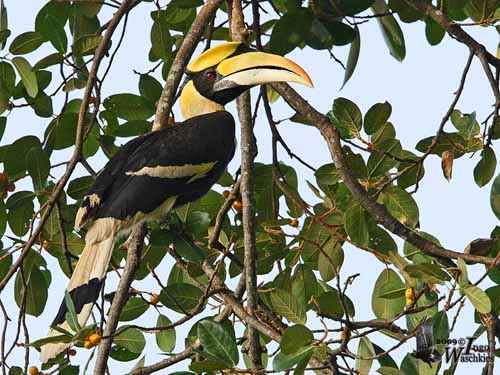
PROTECTION / THREATS / STATUS:
The Great Hornbill is evaluated as Near Threatened by Birdlife International.
This species is declining in many regions of the range. Deforestation, fragmentation and degradation of the habitat are the main causes. But these birds are also threatened by hunting and trapping for food, trade and tribal medicine use. Their casques are considered trophies.
However, the Great Hornbill occurs in several protected areas and breeds in captivity.
Fr: Calao bicorne
All : Doppelhornvogel
Esp : Cálao Bicorne
Ital: Grande calao indiano
Nd: Dubbelneushoornvogel
Sd: Större hornkorp
Photographer:
Ingo Waschkies
My bird pictures on Pbase
Text by Nicole Bouglouan
Sources:
HANDBOOK OF THE BIRDS OF THE WORLD Vol 6 by Josep del Hoyo-Andrew Elliott-Jordi Sargatal - Lynx Edicions, 2001 - ISBN: 848733430X
HANDBOOK OF THE BIRDS OF INDIA AND PAKISTAN – vol 4 – By Salim Ali and Dillon Ripley – OXFORD UNIVERSITY PRESS - ISBN: 0195659376
LES OISEAUX DE THAILANDE par Roland Eve et Anne-Marie Guigue - Times Editions - ISBN: 9812042008
L’ENCYCLOPEDIE MONDIALE DES OISEAUX - Dr Christopher M. Perrins - BORDAS - ISBN: 2040185607
BirdLife International (BirdLife International)
Wikipedia, the free encyclopaedia
Great Hornbill
Buceros bicornis
Bucerotiforme Order – Bucerotidae Family
BIOMETRICS:
L: 95-105 cm
Poids: M: 2600-3400 g – F: 2155-3350 g
DESCRIPTION:
The Great Hornbill is the largest member of this family. This large arboreal bird is able to perform acrobatic flights during the breeding season.
The adult male has black and white plumage with some white parts washed yellow. This is due to the oily exudation produced by the uropygial gland when the bird is preening. It rubs its head against the gland situated at the upper base of the tail, and transfers this oil to its plumage.
Back and underparts are black, except the white lower belly, upper and undertail-coverts and tail. The latter shows a broad black subterminal band.
The upperwing is black with white coverts forming a conspicuous wing-bar. The flight feathers are broadly tipped white.
The underwing is black and white with black coverts, and black flight feathers with white bases and tips.
The neck is creamy-white to buff-yellow. This colour is transferred by the bird from the uropygial gland to the feathers when it is preening.

On the head, face and chin are black, and hind-crown and nape are yellow. The male has a huge yellow and black U-shaped casque on the upper base of the bill and the forecrown, double-pointed at front and bordered with black. The long, down-curved bill has yellowish upper mandible with reddish tip, and paler lower mandible, rather whitish at base with yellow tip. Both mandibles are serrate.
The eyes are deep red with black eye-ring. Legs and feet are blackish.
The female has similar plumage but she is smaller, with smaller yellow casque bordered with red. She has white eyes with red eye-ring, becoming brighter during the breeding season.
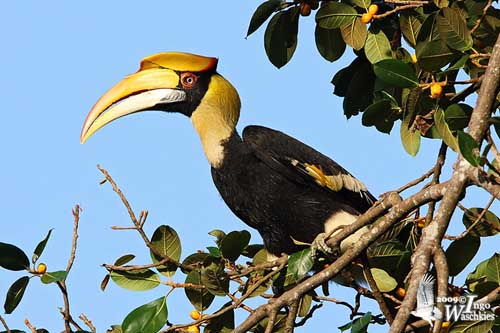
The juvenile has blue-grey eyes and smaller bill. It lacks the casque which grows over five years. The Great Hornbill may live about 35-40 years.
VOICE: SOUNDS BY XENO-CANTO
The Great Hornbill gives deep, hoarse grunts, barks and roars. It is more vocal and noisy when the breeding season starts.
The casque is a kind of resonating chamber which amplifies the loud, nasal, honking call “tok” repeated at regular intervals while the bird stretches the neck vertically up with the bill pointed upwards.
HABITAT:
The Great Hornbill is largely sedentary in large tracts of evergreen forests, but it can be seen when crossing open areas between two tracts. This species occurs up to 2000 metres in the Himalayas, and usually from lowlands up to 1500 metres of elevation.
RANGE:
The Great Hornbill is resident in its range, only performing local movements according to the food resources, especially the fruiting trees.
This species has fragmented range in South and Southeast Asia. It occurs in SW India, S Himalayas, NC Myanmar, S China and Vietnam, Malay Peninsula and Sumatra.
BEHAVIOUR:
The Great Hornbill feeds mainly on fruits, and occasionally on buds and flowers. It also takes large insects, arthropods, small reptiles, young birds and small rodents.
Figs are their preferred food, making up 73% of their diet, and the main food item delivered at nest. But it feeds on several rich fruits from about 18-20 genera.
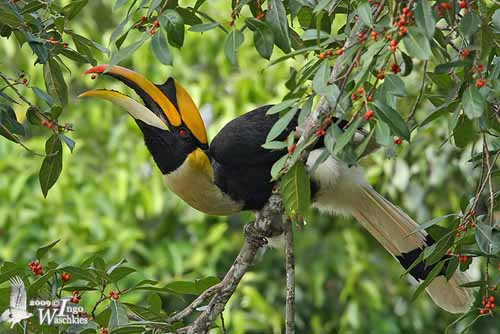
It forages primarily in the canopy, but it also descends to the ground for the fallen fruits. It is often seen in pairs or in family groups. But a good food source such as fruiting trees may gather numerous hornbills. Outside the breeding season, they roost in flocks of several tens of birds. They roost among the highest branches in foliage, and they are often distributed over several trees, with 3-4 birds in each.
The Great Hornbill moves by quick and buoyant sideway hops, from branch to branch. During one day, it can visit several fruiting trees and covers long distances to feed. It follows the same routes every day, as well for feeding as for roosting.
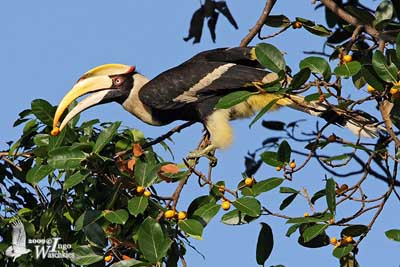
The Great Hornbill is monogamous and territorial. At the beginning of the breeding season, the male performs aerial displays and acrobatic flights to attract a mate. The males may sometimes engage in “head-to-head” or aerial casque-butting, only to “win” a female.
Both mates may perform duets and call in unison, giving rapid roars and barks.
They nest in tree holes where the female remains with the young. She depends on the male for food during this period. This is also a good protection against the predators.
FLIGHT:
The Great Hornbill has laboured noisy flight. It performs some steady wing-beats interspersed with glides on outspread wings and spread tail.
The flight is noisy, producing a loud, scraping noise both in flapping and gliding. This noise can be heard at considerable distances.
REPRODUCTION:
The breeding season occurs between January and April.
The nest is a natural cavity placed between 8 and 35 metres above the ground in large forest tree. There is an elongated entrance. Once the female is inside, both mates seal the entrance with dung and pellets of mud. Male and female work together. They leave a small slit and the male will bring the food to the female while she incubates. Then, she will feed the chicks with the food brought by the male at nest. The female moults while she is inside the hole.
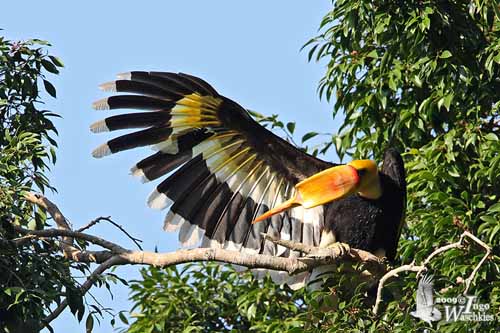
She lays 2 eggs at 4-5 days intervals. She incubates during 38-40 days. The male feeds her and the chicks by regurgitation through the small gullet.
The female emerges before the young fledge. The young birds seal the entrance again and are fed by both parents. They fledge between 72 and 96 days.
The whole nesting cycle lasts about 100-140 days.
DIET:
The Great Hornbill feeds mainly on fruits, especially figs from several trees’ species. It also takes large insects, lizards, snakes, small rodents and chicks of other bird species.
The prey are caught, the largest are sometimes beaten, and then tossed in the air before to be swallowed.
